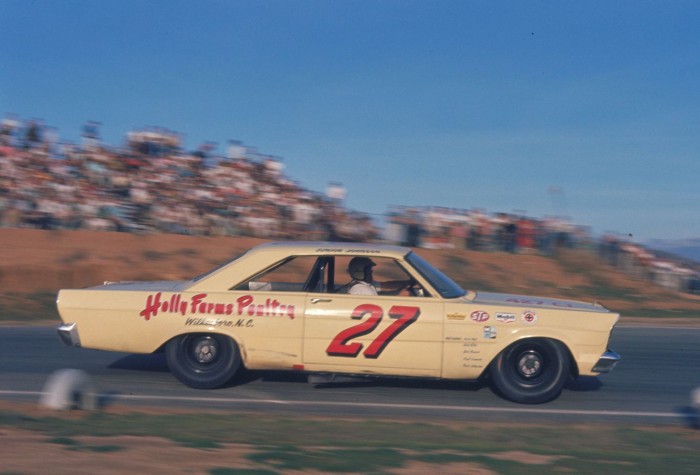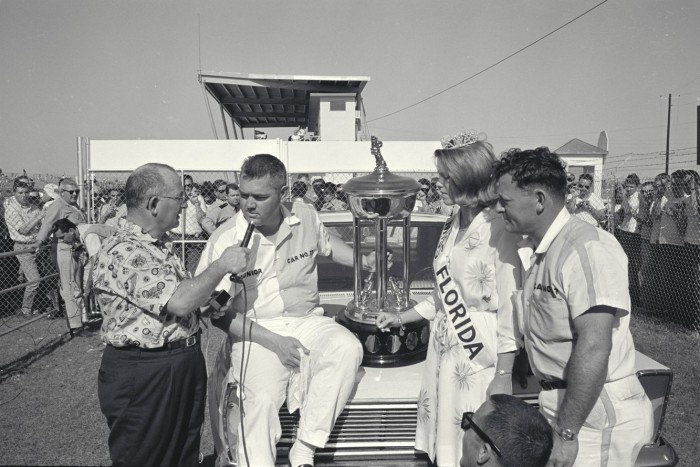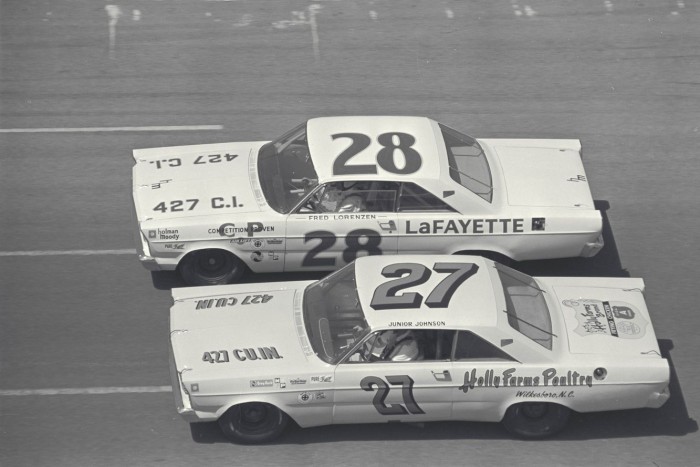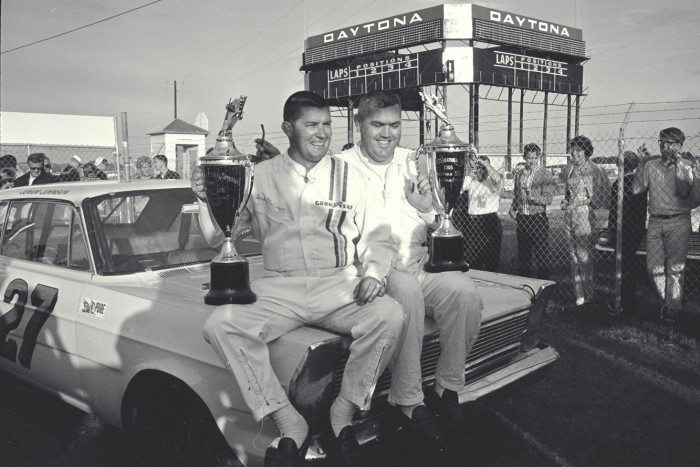Racing Heroes – Junior Johnson
Posted on Feb 17, 2017 in Featured | 2 comments

Junior Johnson at the Riverside 500 in 1965. Photos courtesy Ford Motorsport, unless otherwise indicated.
Editor’s note: This piece comes to us from new Hemmings contributor Steve Thomas.
Ripping down a barely-paved county road in the mountains of North Carolina with revenue agents closing in isn’t what you’d typically think of as training for one of American motorsport’s best-known drivers, mechanics and business owners. NASCAR’s bootlegging roots bred many great drivers, but Junior Johnson is the name that led from the sport’s outlaw beginnings to the billion-dollar enterprise it is today.
Born June 28, 1931, in Ingle Hollow, North Carolina, Robert Glen Johnson, Jr. was part of a family of farmers who supplemented their income by making moonshine. Junior helped out any way he could, and by the age of 14 was showing his natural driving prowess as a bootlegger, delivering his father’s moonshine to drop-off points.
His 1940 Ford sedan became infamous among the police and famous among the other bootleggers. Using his skills as a mechanic, he built the car into a fast, reliable runner that handled well enough to keep him out of the hands of the law.

Johnson being interviewed at Daytona, 1965.
As the other bootleggers began to gather to race among themselves to prove who really did have the fastest cars and best driving skills, Junior showed he could drive fast even without police in his rearview mirror. Placing second the first time he ever raced, Junior saw that he could make pretty good money racing on weekends. Honing his skills as a mechanic and driver, Junior continued to bootleg and race.
After years racing on dirt tracks and winning championships at every level, Johnson entered the NASCAR Grand National circuit for his first full season in 1955. He again proved himself a talent among the best by winning five races and finishing sixth in the points standing. If there would have been an official NASCAR Rookie of the Year award in 1955 (it was awarded for the first time in 1957), Junior would have easily been the recipient.
Junior spent most of the 1956 season behind bars. He was arrested while carrying wood to the family still on the morning of May 2, 1956. At the time, many thought the arrest was a set up by area police to get Junior away from his car for a while, because they had no chance of catching him behind the wheel. He spent 11 months of a two-year sentence behind bars, but ultimately received a full pardon from President Ronald Reagan on December 26, 1986.

In victory lane at the 1965 Rebel 300.
Out of prison and back to racing, Junior got back to his winning ways by taking six firsts in 1958 and five more in 1959. Then in 1960, the legend of Junior Johnson was solidified at the second annual Daytona 500. Early in his career, Johnson was thought of as the best short-track racer in the field, but the superspeedways proved to be a bit more problematic. His car wasn’t as fast on these tracks as his competitors, and this was especially true on the high banks of Daytona. Living up to his image as a resourceful, tenacious racer who would do whatever it takes to win, he stumbled onto a tactic that would quickly become common among NASCAR drivers. He found that if he tucked in close behind the faster cars on the track, his speed would also increase. The slipstream of the car in front would pull him along, and if he timed it perfectly, he could catapult himself ahead of the car. Drafting, he was able to win his first race on a longer superspeedway.
In 1965, Tom Wolfe wrote an article for Esquire magazine titled “Great Balls of Fire.” In it, the character of Junior Johnson, the outlaw origins of sport, the unbelievably fast American cars and the lifestyle surrounding them brought stock car racing to a wider audience. It gave NASCAR, and especially Junior, fame outside the racing world. In 1970, the movie The Last American Hero, based on Wolfe’s essay and starring Jeff Bridges as the fictionalized Junior character, was released to critical and audience acclaim, furthering his image in the public eye.

Going wheel-to-wheel with Freddie Lorenzen at Daytona in 1965.
Junior retired from racing as a driver in 1966. For many, this would have been enough. He had amassed 50 NASCAR wins, capturing victory on nearly every track of the day. He is the winningest racer to have never won a championship, and that simple statistic speaks to his personality as a driver. He was in it to win it; he wasn’t chasing points, and many knew him as the go-or-blow king. Maybe that mentality came from his bootlegging days where, if you didn’t outrun those behind you, jail was the likely outcome. Even with the win-at-all-costs mentality, Junior raced in 313 NASCAR races, had 46 poles, 121 top-five finishes and 148 top-10 finishes. His winning percentage was 15.9-percent, making him sixth in the category. He’s 11th in the all-time wins category and 11th for number of poles.
Though Johnson had retired from driving, his legacy in the sport of stock car racing was just beginning to take shape. He became a team owner in 1965 and proved he was as adept at managing a team as he was managing a car around the race track.
As a team owner, he worked with some of NASCAR’s most legendary drivers, including Darel Dieringer, LeeRoy Yarbrough, Cale Yarborough, Bobby Allison, Darrell Waltrip, Neil Bonnett, Terry Labonte, Geoffrey Bodine, Sterling Marlin, Jimmy Spencer and Bill Elliott. As an owner, his drivers won 1,049 races, which is third behind Petty Enterprises and Hendrick Motorsports. Johnson’s team drivers also won six Winston Cup Championships, including Cale Yarborough in 1976-1978 and Darrell Waltrip 1981-1982 and 1985.

Leading Richard Petty at Bristol in 1964. Photo courtesy Daytona Racing Archives.
The Junior Johnson do-what-it-takes-to-win attitude was on display even as an owner. For the second time in the sport’s history, 1966 saw a major manufacturer boycott NASCAR because one of its engines was outlawed. In 1965, it was the Chrysler 426 Hemi leaving Chrysler and Plymouth drivers, including Richard Petty, out of the hunt. In 1966, Ford saw their overhead cam 427 banned. NASCAR was seeing a drop in revenues, because fans were not going to the tracks since some of the top racers weren’t on the track.
On August 7, 1966, at the Atlanta Raceway, Junior’s team fielded their modified 1966 Ford Galaxie. The Galaxie had its top chopped – estimates from the day say it was chopped anywhere from 3 to 5 inches – and the windshield was laid back 20 degrees. The front of the car was lowered, too, and the rear quarter panels were swept upward to produce more down force. It was this mod that earned the Galaxie the nickname of “Yellow Banana” for its then-unusual stance. Each of these modifications was clearly outside of the rules, but the Yellow Banana, as well as Smokey Yunick’s black-and-gold Chevy Chevelle, were allowed to race. When the 1967 race season arrived, NASCAR instituted the first body templates.
It wasn’t just pushing the limits of the cars…and the rulebooks…that made Junior a force among NASCAR owners. He also thought outside the lines as a businessman, using his do-what-it-takes mentality to approach R.J. Reynolds for sponsorship money in 1970. He knew the company was flush with marketing money since the federal government had recently banned television ads by cigarette manufacturers. Junior did such a good job selling the fact that there were millions of fans, many of whom were smokers, and that sponsoring his team would be a great way to get the R.J. Reynolds brand in front of them, that RJ Reynolds decided to sponsor the entire National Division. Thus, the Winston Cup was born.

With second-place Darel Dieringer at Daytona in 1965.
In the mid-’90s, Junior sold his team to Bret Bodine and retired to his farm in North Carolina, close to the property and roads where he first learned about cars and driving fast.
His racing accolades are many. In 1991 he was inducted into the Motorsports Hall of Fame of America, and in 1998 he was named one of NASCAR’s 50 Greatest Drivers. On May 23, 2010, he was inducted into inaugural class of NASCAR’s Hall of Fame, along with Richard Petty, Dale Earnhardt, Bill France Jr. and Bill France Sr., esteemed company, to say the least.
He’s admired today for his good-old-boy demeanor, and he embodied the values of the working class fans of stock car racing. Through his hard work and God-given talents, he made a successful career racing cars, turning wrenches and even leading others in the boardroom. As an owner, he ushered the sport out of small garages and into the high-tech facilities they use today, and he brought more money and bigger sponsorships into NASCAR. He was the old guard that laid the groundwork for the new school and did it all while winning races.





.gif)


When Nascar became more available to watch on tv I used to watch as many races as I could. I guess that would have been in the mid to late 80’s. As those drivers went to the sidelines over time, there seemed to be a change from the bump and grind method to a more anticeptic style of racing.
And there seems to be a emphasis on “pretty” drivers who look good on tv. And those who step out of line, had better watch out. Don’t want to piss off corporate america at any cost.
The ultimate irony is every time Junior is mentioned on Nascar shows now, his bootlegging roots are always mentioned. If he was an up and coming driver now, his record would prevent him from ever attaining the top tier of stock car racing.
Yeah, I don’t like how that’s always brought up. There are still guys like Junior around, you’ll find them making their living at dirt tracks all around the country.